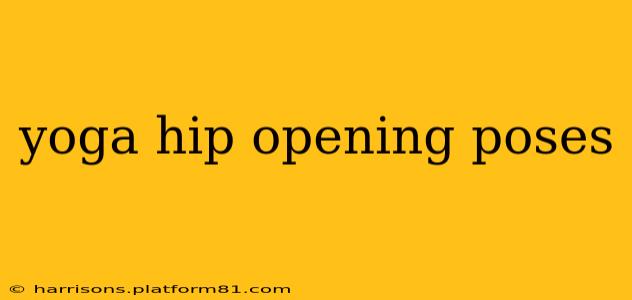Tight hips? You're not alone. Many of us spend hours sitting, leading to restricted hip mobility and potential discomfort. Fortunately, yoga offers a fantastic way to alleviate this tightness and improve overall flexibility. This comprehensive guide explores various yoga hip opening poses, explaining their benefits and providing modifications for different levels. We'll also address common questions surrounding hip opening practices.
Why are Hip Openers Important?
Before diving into the poses, let's understand why hip opening is so crucial. Tight hips can contribute to various physical issues, including:
- Lower back pain: Restricted hip movement often compensates by putting extra strain on the lower back.
- Reduced range of motion: Limited hip flexibility can impact your ability to perform everyday activities with ease.
- Poor posture: Tight hips can contribute to slouching and an overall imbalance in your posture.
- Sciatica: In some cases, tight hips can exacerbate sciatic nerve pain.
- Limited athletic performance: Flexibility is key for optimal athletic performance, and tight hips can hinder your progress.
Beginner-Friendly Hip Opening Poses
Starting your hip opening journey requires gentle poses to build flexibility gradually. Here are some excellent options:
-
Wide-Legged Forward Fold (Prasarita Padottanasana): This pose gently stretches the inner thighs, groins, and hamstrings, contributing to hip opening. Focus on lengthening your spine and relaxing your head and neck.
-
Pigeon Pose (Kapotasana): A classic hip opener, Pigeon Pose can be modified for beginners by placing a blanket or bolster under the hips for support. This variation reduces the intensity and allows for a deeper stretch over time.
-
Butterfly Pose (Baddha Konasana): Sit comfortably with the soles of your feet together and gently press your knees towards the floor. This pose stretches the inner thighs and groins. You can use your elbows to gently press your knees down, but avoid forcing the stretch.
-
Reclined Butterfly Pose (Supta Baddha Konasana): This variation of Butterfly Pose is more relaxing. Lie on your back with the soles of your feet together and let your knees fall open. Place a blanket or bolster under your knees for added comfort and support.
Intermediate and Advanced Hip Openers
Once you've established a foundation of flexibility, you can progress to more challenging poses:
-
Lizard Pose (Utthan Pristhasana): This pose deeply stretches the hips, groin, and quads. Modifications include keeping the back knee on the ground or using blocks for support.
-
King Pigeon Pose (Eka Pada Rajakapotasana): A deeper variation of Pigeon Pose, King Pigeon requires more flexibility and balance. Use props as needed to support your body and avoid strain.
-
Bound Angle Pose (Baddha Konasana) with Forward Fold: This combines the benefits of Bound Angle Pose with a forward fold, creating a deeper stretch in the hips and thighs.
-
Half Frog Pose (Ardha Bhekasana): This pose targets the external rotators of the hip and requires significant hip flexibility.
How Often Should I Do Hip Opening Exercises?
The frequency of your practice depends on your fitness level and goals. Aim for at least 2-3 sessions per week, holding each pose for 30 seconds to 1 minute. Listen to your body and avoid pushing yourself too hard, especially when starting.
What are the benefits of hip opening yoga?
The benefits extend far beyond increased flexibility. Regular hip opening practice can lead to improved posture, reduced back pain, increased range of motion, and a greater sense of overall well-being. It can also enhance athletic performance and promote relaxation and stress reduction.
Can I do hip opening exercises every day?
While daily practice might seem beneficial, it's crucial to listen to your body. Overdoing it can lead to injury. Rest days are essential for muscle recovery and allowing your body to adapt to the stretches. Consider alternating between hip opening and other types of yoga or exercise.
Are there any contraindications for hip opening poses?
Certain conditions may make some hip opening poses unsuitable. Individuals with hip injuries, recent surgeries, or other medical concerns should consult their doctor or physical therapist before starting any new exercise program. Pregnancy also requires modifications and potentially different poses.
Conclusion
Incorporating hip opening yoga poses into your routine can significantly improve your physical and mental well-being. Remember to listen to your body, start slowly, and gradually increase the intensity of your practice as your flexibility improves. With consistent effort, you’ll experience the many benefits of improved hip mobility and a healthier, more flexible body.
